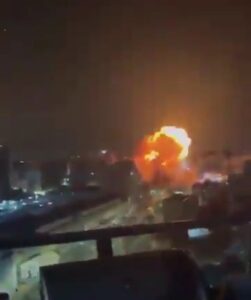Israel-Iran Conflict Escalates: Devastation Mounts as Airstrikes and Missile Barrages Intensify

June 15, 2025 – Jerusalem/Tehran – The long-simmering tensions between Israel and Iran have erupted into open warfare, marking the most intense direct confrontation between the two nations in decades. Following Israel’s large-scale military operation, dubbed “Rising Lion,” which began on June 13, 2025, both countries have exchanged devastating barrages of airstrikes and missiles, resulting in significant destruction, loss of life, and fears of a broader regional conflict. Below is a detailed account of the latest developments and the toll on both sides.
Israel’s Operation Rising Lion: A Bold Strike on Iran
On June 13, 2025, Israel launched a series of airstrikes targeting Iran’s nuclear facilities, military bases, and key leadership, aiming to cripple Tehran’s nuclear ambitions and military capabilities. The Israeli military struck at least six military bases and highly secured housing complexes for military commanders around Tehran, as well as the Natanz nuclear enrichment site, which was partially destroyed.
The attacks killed several high-ranking Iranian military officials, including Mohammad Bagheri, a top commander in the Islamic Revolutionary Guard Corps (IRGC), and Hossein Salami, the IRGC’s commander since 2019. Additionally, six top nuclear scientists were reported dead, dealing a significant blow to Iran’s nuclear program.� that 78 people were killed and approximately 300 injured in the Israeli strikes, including civilians and 20 children in a collapsed 14-story residential building near Nobonyad Square in Tehran.
Iranian state television broadcast images of smoke and fire billowing from residential areas, with significant structural damage reported in Tehran’s Saadat Abad Street and other neighborhoods. While Iran insists its nuclear program is for peaceful purposes, the destruction of the above-ground pilot enrichment plant at Natanz has raised questions about the extent of damage to its underground centrifuge facilities, which remain a critical component of its nuclear ambitions.
Iran’s Retaliation: Missiles Rain on Israel
Iran responded swiftly with retaliatory airstrikes and missile barrages targeting Israeli cities, including Jerusalem, Tel Aviv, and Haifa. On Friday night and into Saturday, Iran’s IRGC launched over 200 ballistic missiles and drones, with explosions reported across central and northern Israel. A verified video showed a fire burning near the Haifa oil refinery, though the extent of the damage remains unclear.
Israeli authorities reported at least three deaths, including two people killed in central Israel early Saturday and a woman who succumbed to injuries in a Tel Aviv suburb. Dozens more were injured as air raid sirens blared across the country. A large explosion in Tel Aviv’s Kirya area, home to government and military facilities, damaged several buildings, though Israel’s Iron Dome intercepted many incoming missiles.
Iran’s Supreme Leader, Ayatollah Ali Khamenei, vowed “severe punishment” for Israel, signaling that further retaliation may be imminent. Iran also launched drones that crossed Jordanian and Iraqi airspace, prompting both nations to close their airspace temporarily.
Destruction and Its Toll
The scale of destruction on both sides is staggering. In Iran, the loss of key military and scientific personnel, coupled with damage to nuclear and military infrastructure, has weakened its immediate defensive and offensive capabilities. The collapse of a residential building in Tehran and reports of civilian casualties, including children, have fueled domestic outrage and calls for vengeance.
In Israel, the missile strikes have caused significant disruption, with damage to civilian and military infrastructure in major cities. The psychological toll on the population is evident, as air raid sirens and emergency alerts have become a constant feature of daily life. The Israeli military has vowed to continue its campaign, with Prime Minister Benjamin Netanyahu stating that the strikes aim to dismantle Iran’s “weaponization program” and potentially destabilize its regime.
Global Implications and Reactions
The escalating conflict has sent shockwaves through global markets, with oil prices surging over 10% due to fears of disrupted energy supplies from the Middle East. Iran’s strategic position near the Strait of Hormuz raises concerns that it could block oil and gas exports, further destabilizing the global economy.
U.S. President Donald Trump, who has expressed support for Israel, urged Iran to negotiate a nuclear deal to avoid further destruction, warning, “Iran must make a deal, before there is nothing left.” However, nuclear talks scheduled for June 15 in Muscat, Oman, were canceled amid the hostilities. The U.S. has positioned warships and military assets in the region to protect Israel and its own troops, raising fears of American involvement in a broader conflict.
International calls for de-escalation have grown louder. Canadian Foreign Affairs Minister Anita Anand warned of “devastating consequences” if the conflict widens, while China condemned Israel’s actions as a violation of Iran’s sovereignty. Russian President Vladimir Putin and Trump discussed the crisis, expressing interest in reviving nuclear negotiations, but no concrete steps have emerged.
A Region on Edge
The Israel-Iran conflict, once characterized by proxy wars and covert operations, has now entered a dangerous new phase. Israel’s strikes have severely weakened Iran’s nuclear and military capabilities, but the resilience of its underground facilities suggests the program may not be entirely dismantled. Iran’s retaliatory missile strikes have demonstrated its ability to hit Israeli cities, though its weakened position—following the decimation of allies like Hamas and Hezbollah—limits its options.
Analysts warn that the conflict could last weeks, if not longer, with the potential to draw in other regional and global powers. The destruction on both sides—human, structural, and strategic—has already reshaped the Middle East’s geopolitical landscape, with the risk of further escalation looming large.
As the world watches, the question remains whether diplomacy can halt the cycle of violence or if the region is on the brink of a multi-front war. For now, both Israel and Iran appear committed to their respective campaigns, leaving civilians on both sides to bear the brunt of the destruction.
Sources: The New York Times, Reuters, BBC, AP News, Al Jazeera, The Washington Post





